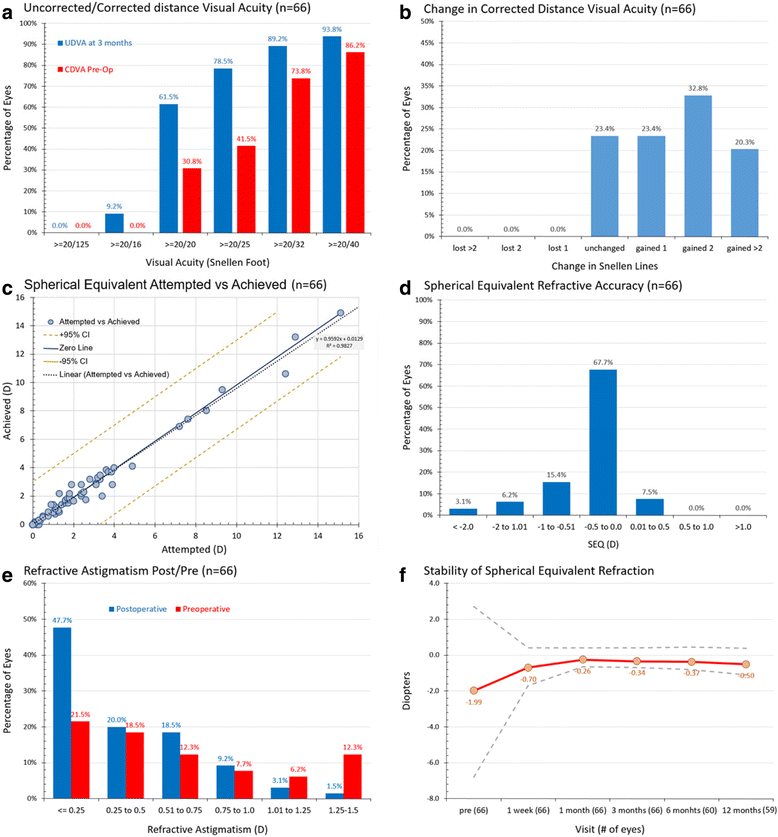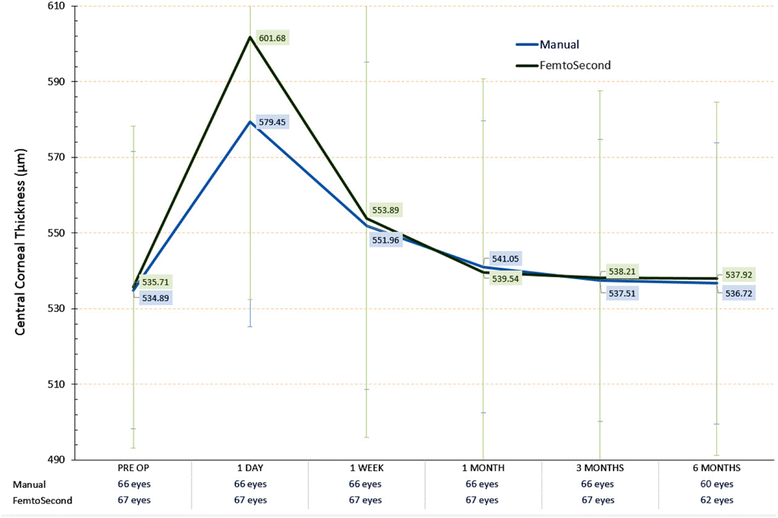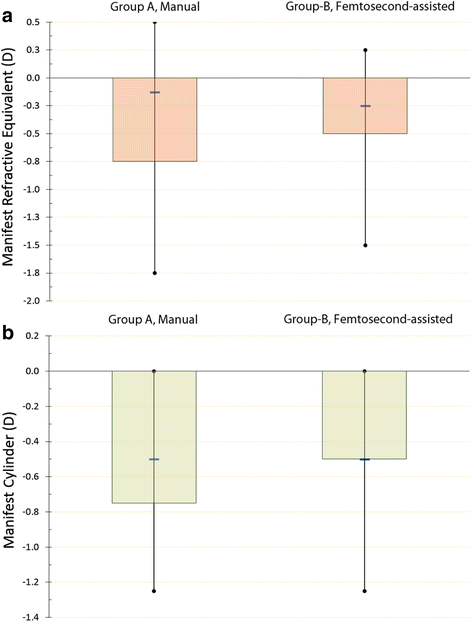Standard manual capsulorhexis / Ultrasound phacoemulsification compared to femtosecond laser-assisted capsulorhexis and lens fragmentation in clear cornea small incision cataract surgery
- PMID: 27478858
- PMCID: PMC4967293
- DOI: 10.1186/s40662-016-0050-x
Standard manual capsulorhexis / Ultrasound phacoemulsification compared to femtosecond laser-assisted capsulorhexis and lens fragmentation in clear cornea small incision cataract surgery
Abstract
Background: Femtosecond-laser assisted clear cornea cataract surgery may hold promise in safer and more effective procedures. We decided to perform a comparative study to standard manual incision phacoemulsification surgery.
Methods: This is a single-center, single-intervention, and prospective comparative data evaluation of 133 consecutive cases subjected to cataract surgery. Group-A (Phaco), manual capsulorhexis & ultrasound phacoemulsification (n = 66); Group-B femtosecond-laser assisted capsulorhexis and lens fragmentation (n = 67), employing the LenSx laser (Alcon Surgical, Ft. Worth, TX). All cases were evaluated for refraction, visual acuity, keratometry, tomography, pachymetry, endothelial cell counts, intraocular pressure, and type of intraocular lens (IOL) implanted. The groups were matched for age, gender, pre-operative vision metrics, and cataract grade, and were followed up to 1 year.
Results: In group-A post-operative uncorrected distance visual acuity (UDVA) was 20/20 or better in 61.5 % and 20/25 or better in 78.5 % of the eyes. The femtosecond laser group-B had improved outcomes (p = 0.075 and p = 0.042, respectively): post-operative UDVA was 20/20 or better in 62.7 % of the eyes and 20/25 or better in 85.1 %. Linear regression scatterplots of achieved versus attempted spherical equivalent had excellent regression coefficients (r (2) = 0.983 in group-A and 0.979 in group-B). There were 75.2 % cases in group-A and 80.6 % in group-B (p = 0.8732) within ±0.50 D of targeted refractive equivalent. Slight trend of under-correction was noted in group-A. Average residual manifest cylinder in the toric subgroup-A was -0.50 D (95 % Limit-of-Agreement (LoA) = -0.78 D), and in toric subgroup-B -0.45 D (LoA = -0.45 D).
Conclusions: Mean spherical equivalent refraction and visual acuity are comparable with laser cataract surgery compared with manual capsulorhexis & ultrasound phacoemulsification. Improved astigmatism correction may be among the benefits of femtosecond laser-assisted cataract surgery. Transient corneal edema may be a first day transient disadvantage in femtosecond laser-assisted cataract surgery.
Keywords: Clear cornea small-incision cataract surgery; Corneal edema; Endothelial cell counts; Femto-second laser cataract surgery; Manual capsulorhexis LenSx; Phacoemulsification; Refractive outcomes; Toric IOL.
Figures





Similar articles
-
Comparative clinical outcomes of Tecnis toric IOL implantation in femtosecond laser-assisted cataract surgery and conventional phacoemulsification surgery.Int J Ophthalmol. 2020 Jan 18;13(1):49-53. doi: 10.18240/ijo.2020.01.07. eCollection 2020. Int J Ophthalmol. 2020. PMID: 31956569 Free PMC article.
-
Outcomes of toric intraocular lens implantation after femtosecond laser and traditional cataract surgery.Clin Exp Optom. 2021 Jan;104(1):69-73. doi: 10.1111/cxo.13099. Clin Exp Optom. 2021. PMID: 32519369
-
Optical coherence tomography and 3-dimensional confocal structured imaging system-guided femtosecond laser capsulotomy versus manual continuous curvilinear capsulorhexis.J Cataract Refract Surg. 2014 Dec;40(12):2035-43. doi: 10.1016/j.jcrs.2014.05.032. Epub 2014 Oct 23. J Cataract Refract Surg. 2014. PMID: 25450242 Clinical Trial.
-
The use of femtosecond lasers in cataract surgery: review of the published results with the LenSx system.J Refract Surg. 2014 Nov;30(11):730-40. doi: 10.3928/1081597X-20141021-04. J Refract Surg. 2014. PMID: 25375845 Review.
-
Femtosecond-laser assisted cataract surgery: a review.Acta Ophthalmol. 2014 Nov;92(7):597-603. doi: 10.1111/aos.12416. Epub 2014 May 19. Acta Ophthalmol. 2014. PMID: 24835818 Review.
Cited by
-
Clinical outcomes of femtosecond laser-assisted cataract surgery versus conventional phacoemulsification: A retrospective study in a tertiary eye care center in South India.Indian J Ophthalmol. 2022 Dec;70(12):4300-4305. doi: 10.4103/ijo.IJO_802_22. Indian J Ophthalmol. 2022. PMID: 36453333 Free PMC article. Review.
-
Effect of femtosecond laser-assisted lens surgery on the optic nerve head and the macula.Int J Ophthalmol. 2019 Jun 18;12(6):961-966. doi: 10.18240/ijo.2019.06.13. eCollection 2019. Int J Ophthalmol. 2019. PMID: 31236353 Free PMC article.
-
Comparison of macular changes and visual outcomes between femtosecond laser-assisted cataract surgery and conventional phacoemulsification surgery for high myopic cataract patients.BMC Ophthalmol. 2024 May 15;24(1):212. doi: 10.1186/s12886-024-03479-6. BMC Ophthalmol. 2024. PMID: 38750496 Free PMC article.
-
Reviewing the visual benefits of femtosecond laser-assisted cataract surgery: Can we improve our outcomes?Indian J Ophthalmol. 2017 Dec;65(12):1314-1322. doi: 10.4103/ijo.IJO_736_17. Indian J Ophthalmol. 2017. PMID: 29208811 Free PMC article. Review.
-
Outcomes study between femtosecond laser-assisted cataract surgery and conventional phacoemulsification surgery using an active fluidics system.Clin Ophthalmol. 2017 Sep 25;11:1735-1739. doi: 10.2147/OPTH.S136136. eCollection 2017. Clin Ophthalmol. 2017. PMID: 29026283 Free PMC article.
References
LinkOut - more resources
Full Text Sources
Other Literature Sources

